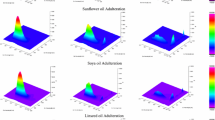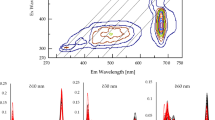Abstract
Artificial neural networks (ANNs) were built with excitation-emission matrix fluorescence (EEMF) spectra of essential oils for the investigation of their adulteration. With self-organized maps (SOMs), the clusters formed by all the types of essential oils were visualized. Pure essential oils were globally separated from their adulterated samples. The nature of the adulterant (vegetable oil, essential oil, solvent) in adulterated essential oils was revealed by a multilayer perceptron (MLP) network which classified them with a percentage of correct classification of 92.31%. In the case of the adulteration of neroli essential oil by sunflower vegetable oil, with another multilayer perceptron network, the level of adulteration was globally well evaluated. The correlation coefficient between true and evaluated adulteration percentages was 0.951. The samples corresponding to the adulteration percentage of 5% were the worse evaluated.






Similar content being viewed by others
References
Aroca-Santos R, Cancilla JC, Matute G, Torrecilla JS (2015) Identifying and quantifying adulterants in extra virgin olive oil of the Picual varietal by absorption spectroscopy and nonlinear modeling. J Agric Food Chem. doi:10.1021/acs.jafc.5b01700
Azcarate SM, de Araújo GA, Alcaraz MR, Ugulino de Araújo MC, Camiña JM, Goicoechea HC (2015) Modeling excitation–emission fluorescence matrices with pattern recognition algorithms for classification of Argentine white wines according grape variety. Food Chem 184:214–219
Bergmeir C, Benítez JM (2012) Neural networks in R using the Stuttgart neural network simulator: RSNNS. J Stat Soft 46:1–26
Bieroza M, Baker A, Bridgeman J (2009) Exploratory analysis of excitation-emission matrix fluorescence spectra with self-organizing maps as a basis for determination of organic matter removal efficiency at water treatment works. J Geogr Res. doi:10.1029/2009JG000940
Bieroza M, Baker A, Bridgeman J (2012) Exploratory analysis of excitation–emission matrix fluorescence spectra with self-organizing maps—a tutorial. Educ Chem Eng 7:e22–e31
Bilke S, Mosandl A (2002) Authenticity assessment of lavender oils using GC-P-IRMS: 2H/1H isotope ratios of linalool and linalyl acetate. Eur Food Res Tech 214:532–535
Bishop CM (1995) Neural networks for pattern recognition. CLARENDON PRESS, Oxford
Boren KE, Young DG, Woolley CL, Smith BL, Carlson RE (2015) Detecting essential oil adulteration. J Env Anal Chem
Brereton RG (2009) Chemometrics for pattern recognition. John Wiley & Sons, West Sussex
Bun Ng T, Fei Fang E, El-Din Ahmed Bekhit A, Ho Wong J (2016) Methods for the characterization, authentication, and adulteration of essential oils. In: Preedy V (ed) Essential oils in food preservation. Flavor and Safety. Elsevier Inc., Amsterdam, pp 11–17
Burfield T (2003) The adulteration of essential oils and the consequences to aromatherapy & natural perfumery practice. http://www.users.globalnet.co.uk/~nodice/new/magazine/october/october/october.htm/ Accessed 20 April 2016
Divya O, Mishra AK (2007) Multivariate methods on the excitation emission matrix fluorescence spectroscopic data of diesel–kerosene mixtures: a comparative study. Anal Chim Acta 592:82–90
Djilani A, Dicko A (2012) The therapeutic benefits of essential oils. In: Bouayed J (ed) Nutrition, well-being and health. InTech, Rijeka, pp 155–178
Do TKT, Hadji-Minaglou F, Antoniotti S, Fernandez X (2014) Authenticity of essential oils. Trends Anal Chem 66:146–157
Elzey B, Pollard D, Fakayode SO (2016) Determination of adulterated neem and flaxseed oil compositions by FTIR spectroscopy and multivariate regression analysis. Food Control 68:303–309
García-Reiriz A, Damiani PC, Olivieri AC (2007) Analysis of amoxicillin in human urine by photo-activated generation of fluorescence excitation–emission matrices and artificial neural networks combined with residual bilinearization. Anal Chim Acta 588:192–199
Gowthamarajan K, Kulkarni GT, Subburaju T (2005) Aroma oils as cosmeceutical. Nat Prod Radiance 4:335–338
Guimet F, Ferré J, Boqué R, Rius FX (2004) Application of unfold principal component analysis and parallel factor analysis to the exploratory analysis of olive oils by means of excitation-emission matrix fluorescence spectroscopy. Anal Chim Acta 515:75–85
Isman MB, Miresmailli S, Machial C (2011) Commercial opportunities for pesticides based on plant essential oils in agriculture, industry and consumer products. Photochem Rev 10:197–204
Jain AK, Mao J, Mohiuddin KM (1996) Artificial neural networks: a tutorial. IEEE Comput 29:31–44
JiJi RD, Cooper GA, Booksh KS (1999) Excitation-emission matrix fluorescence based determination of carbamate pesticides and polycyclic aromatic hydrocarbons. Anal Chim Acta 397:61–72
Koenig WA, Hochmuth DH (2004) Enantioselective gas chromatography in flavor and fragrance analysis: strategies for the identification of known and unknown plant volatiles. J Chromatogr Sci 42:423–439
Kohonen T (1998) The self-organizing map. Neurocomputing 21:1–6
Koukos PK, Papadopoulou KI, Patiaka DT, Papagiannopoulos AD (2000) Chemical composition of essential oils from needles and twigs of Balkan pine (Pinus peuce Grisebach) grown in Northern Greece. J Agric Food Chem 48:1266–1268
Kuriakose S, Thankappan X, Joe H, Venkataraman V (2010) Detection and quantification of adulteration in sandalwood oil through near infrared spectroscopy. Analyst 135:2676–2681
Lê S, Josse J, Husson F (2008) FactoMineR: an R package for multivariate analysis. J Stat Soft 25:1–18
Mabrouk S, Elaissi A, Ben Jannet H, Harzallah-Skhiri F (2011) Chemical composition of essential oils from leaves stems, flower heads and roots of Conyza bonariensis L. from Tunisia. Nat Prod Res 25:77–84
Madan MM, Singhal RS, Kulkarni PR (1996) An approach into the detection of authenticity of black pepper (Piper nigrum L.) oleoresin. J Spices Aromat Crops 5:64–67
Mbogning Feudjio W, Ghalila H, Nsangou M, Mbesse Kongbonga YG, Majdi Y (2014) Excitation-emission matrix fluorescence coupled to chemometrics for the exploration of essential oils. Talanta 30:148–154
Nawrocka A, Lamorska J (2013) Determination of food quality by using spectroscopic methods. In: Grundas S, Stepniewski A (eds) Advances in Agrophysical research. Intech, Rijeka, pp 347–367
Nhu-Trang TT, Casabianca H, Grenier-Loustalot M-F (2006) Authenticity control of essential oils containing citronellal and citral by chiral and stable-isotope gas-chromatographic analysis. Anal Bioanal Chem 386:2141–2152
Omrani H, Barnes JA, Dudelzak AE, Loock H-P, Waechter H (2012) Fluorescence excitation–emission matrix (EEM) spectroscopy and cavity ring-down (CRD) absorption spectroscopy of oil-contaminated jet fuel using fiber-optic probes. Analyst 137:2782–2790
R Development Core Team (2008) R: a language and environment for statistical computing. R Foundation for Statistical Computing, Vienna http://www.R-project.org
Scott SM, James D, Ali Z, O’Harea WT, Rowell FJ (2003) Total luminescence spectroscopy with pattern recognition for classification of edible oils. Analyst 128:966–973
Sikorska E, Romaniuk A, Khmelinskii IV, Herance R, Bourdelande JL, Sikorski M, Koziol J (2004) Characterization of edible oils using total luminescence spectroscopy. J Fluoresc 14:25–35
Sikorska E, Khmelinskii I, Sikorski M (2012) Analysis of olive oils by fluorescence spectroscopy: methods and applications. In: Boskou D (ed) Olive oil - constituents, quality. Health Properties and Bioconversions. Intech, Rijeka, pp 63–88
Singhal RS, Kulkarni PR, Rege DV (2001) Quality indices for spice essential oils. In: Peter KV (ed) Handbook of herbs and spices. CRC Press, Boca Raton, pp 22–29
Tanajura da Silva CE, Filardi VL, Muniz Pepe I, Chaves MA, Santos CMS (2015) Classification of food vegetable oils by fluorimetry and artificial neural networks. Food Control 47:86–91
Tongnuanchan P, Benjakul S (2014) Essential oils: extraction, bioactivities, and their uses for food preservation. J Food Sci 79:R1231–R1249
Valeur B (2001) Molecular fluorescence: principles and applications. Wiley-VCH, Weinheim
Wehrens R, Buydens LMC (2007) Self- and super-organizing maps in R: the kohonen package. J Stat Soft 21:1–19
Zellner B’A, Dugo P, Dugo G, Mondello L (2010) Analysis of essential oils. In: Başer KHC, Buchbauer G (eds) Handbook of Essential Oils: Science, Technology, and Applications. Taylor & Francis Group Inc, Boca Raton, pp 151–183
Acknowledgements
The authors gratefully acknowledge support of this work, through NET-45 and OEA-AC-71 projects, by the Abdus Salam International Centre for Theoretical Physics (ICTP, Trieste, Italy). The authors also thank Professor Souad Lahmar for providing the best conditions for the accomplishment of this work.
Author information
Authors and Affiliations
Corresponding author
Ethics declarations
Conflict of Interest
William Mbogning Feudjio declares that he has no conflict of interest. Hassen Ghalila declares that he has no conflict of interest. Mama Nsangou declares that he has no conflict of interest. Youssef Majdi declares that he has no conflict of interest. Yvon Mbesse Kongbonga declares that he has no conflict of interest. Nejmeddine Jaïdane declares that he has no conflict of interest.
Ethical Approval
This article does not contain any studies with human participants or animals performed by any of the authors.
Informed Consent
Not applicable.
Rights and permissions
About this article
Cite this article
Mbogning Feudjio, W., Ghalila, H., Nsangou, M. et al. Fluorescence Spectroscopy Combined with Chemometrics for the Investigation of the Adulteration of Essential Oils. Food Anal. Methods 10, 2539–2548 (2017). https://doi.org/10.1007/s12161-017-0823-4
Received:
Accepted:
Published:
Issue Date:
DOI: https://doi.org/10.1007/s12161-017-0823-4




